Boulogne-sur-Mer
Boulogne-sur-Mer | |
|---|---|
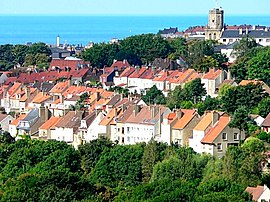 The city, the belfry, the lighthouse and the sea | |
| Country | France |
| Region | Hauts-de-France |
| Department | Pas-de-Calais |
| Government | |
| • Mayor (2012–2014) | Mireille Hingrez-Céréda (PS) |
| Area 1 | 8.42 km2 (3.25 sq mi) |
| Population (2009) | 43,310 |
| • Rank | 2nd in the department, 7th in the region and 59th in France |
| • Density | 5,100/km2 (13,000/sq mi) |
| Time zone | UTC+01:00 (CET) |
| • Summer (DST) | UTC+02:00 (CEST) |
| INSEE/Postal code | 62160 /62200 |
| Elevation | 0–110 m (0–361 ft) |
| Website | http://www.tourisme-boulonnais.fr/uk/ |
| 1 French Land Register data, which excludes lakes, ponds, glaciers > 1 km2 (0.386 sq mi or 247 acres) and river estuaries. | |
Boulogne-sur-Mer (French pronunciation: [bu.lɔɲ.syʁ.mɛʁ], Latin: Bononia, Dutch: Bonen) is a city in northern France. It is a sub-prefecture of the department of Pas-de-Calais. Boulogne lies on the Côte d'Opale, a touristic coast on the English Channel, and is the most-visited location in its region after the Lille conurbation.[1] Boulogne is its department's second-largest city after Calais,[2] and the 59th largest in France.[3] It is also the country's largest fishing port, specialising in herring.[4]
Boulogne was founded during the Roman occupation of France, and as Portus Itius, was used for trade and conquest of Great Britain. After a period of Germanic presence following the collapse of the Empire, Boulogne was at the centre of an eponymous county of the Kingdom of France during the Middle Ages, and was occupied by the Kingdom of England numerous times due to conflict between the two nations.
The city's 12th-century belfry is recognised by UNESCO as a World Heritage Site,[5] while another popular attraction is the marine conservation centre, Nausicaa.
Name
The name Boulogne was first recorded during the Roman Empire as Bononia, possibly a derivative of the root found in the Celtic word bona meaning "foundation", "settlement", "citadel", and also found in Vindobona, the Roman name for Vienna. A "bona" was probably a granary. This derivation is also found in the name of the Italian city of Bologna. This city was founded by the Celtic Boii. The French suffix "-sur-Mer" is the direct equivalent of the English "-on-Sea".
History
Origin of the city
Originally named Gesoriacum and probably also to be identified with Portus Itius, by the 4th century Boulogne was known to the Romans as Bononia and served as the major port connecting the rest of the empire to Britain. The emperor Claudius used this town as his base for the Roman invasion of Britain, in AD 43, and until 296 it was the base of the naval fleet of the Classis Britannica.[6] Zosimus called the city "germanorum", Germanic speaking, at the end of the 4th century.[7] The city was an important town of the Morini.
Middle Ages
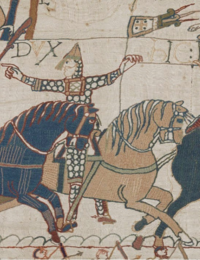
In the Middle Ages Boulogne was the capital of an eponymous county, founded in the mid-9th century. An important Count, Eustace II, assisted William the Conquerer in his conquest of England. His wife founded the city's Notre Dame cathedral, which became a site of pilgrimage from the 12th century onwards, attended by fourteen French kings and five of England. The city survived on herring fishing and received its municipal charter from Count Renaud of Dammartin in 1203.[6]
The area was fought over by the French and the English, including several English occupations during the course of the Hundred Years War. Boulogne was again occupied by the English from 1544 to 1550. In 1550, The Peace of Boulogne ended the war of England with Scotland and France. France bought back Boulogne for 400,000 crowns. A culture of smuggling was present in the city until 1659, when French gains in Flanders from the Treaty of the Pyrenees moved the border northwards.
The Napoleonic period
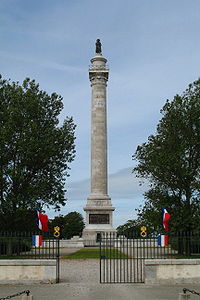
Boulogne received its current status as a subprefecture of the Pas-de-Calais department in 1800 due to the territorial re-organisation in Revolutionary France. Three years later, it was given the title of an Imperial City (Ville Impériale).[6]
In the 19th century the Basilica of Notre-Dame de Boulogne was reconstructed by the priest Benoit Haffreingue after he received a call from God[clarification needed] to reconstruct the town's ruined basilica. During the Napoleonic Wars, Napoleon amassed La Grande Armée in Boulogne to invade the United Kingdom in 1805. However, his plans were halted by other European matters and the supremacy of the Royal Navy (including thousands of Congreve rockets[8]).
Nephew of Bonaparte Louis-Napoleon, later Napoleon III, returned in secret from his exile in England by reaching Boulogne in August 1840. He was jailed for trying to lead a revolt with is citizens. The 19th century was a prosperous one for Boulogne, which became a bathing resort for wealthy Parisians after the completion of a railway line to the French capital.[6]
The two world wars
During the First World War, this was the debarkation port for the first unit of the British Expeditionary Force to land in France, and for many others thereafter. It also was the site of an Allied (French and British) armaments production conference.
On 22 May 1940 during the Battle of France, two British Guards battalions and some pioneers attempted to defend Bolougne against an attack by the German 2nd Panzer Division. Despite fierce fighting, the British were overwhelmed and the survivors were evacuated by Royal Navy destroyers while under direct German gunfire.[9] On June 15, 1944, 297 planes (155 Avro Lancasters, 130 Handley Page Halifaxes, and 12 De Havilland Mosquitos) of the Royal Air Force bombed Boulogne harbour to suppress German naval activity following D-Day. Some of the Lancasters carried Tallboy bombs, and as a result, the harbour and the surrounding area were completely destroyed. In August, 1944 the town was declared a "fortress" by Adolf Hitler, but it succumbed to assault and liberation by the 3rd Canadian Infantry Division in September. In one incident, a French civilian guided the Canadians to a "secret passage" leading into the walled old town and by-passing the German defenders.[10]
To replace the destroyed urban infrastructure, affordable housing and public facility projects in functional, brutalist building styles were carried out in the 1950s and 60s. The harbour, therefore, is not typical of a northern French harbour.
Sights

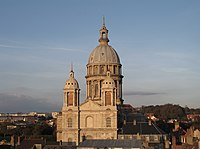
Boulogne's 12th-century Belfry is one of 56 in northeastern France and Belgium with shared World Heritage Site status. It is the oldest building in the upper city, and currently serves as the home to a museum of Celtic remains from the Roman occupation. Founded as the Counts' dungeon, the top floor was added in the 13th century. Damage by a fire in 1712 was built over by 1734.[5]
- Medieval castle, whose foundations date to Roman times. It houses an Egyptian art collection
- Gothic church of St. Nicholas, housing several 15th century statues
- Cathedral basilica of Notre-Dame, with a dome standing at over 100 m. The crypt is one of the largest in France, and has Roman, Romanesque and Gothic elements.
- Opened in 1991, Nausicaä - The French National Sea Centre is a science centre entirely dedicated to the relationship between mankind and the sea. It houses Aquaria, exhibitions on the marine fauna, and the exploitation and management of marine resources (fisheries, aquaculture, coastal planning, maritime transport, exploitation of energies and mineral, tourism).
- The Boulogne Eastern Cemetery, created during the Great War
- Colonne de la Grande Armée - Statue of Napoleon I
Official website: Tourism in Boulogne sur Mer
Official website: Tourism in Boulogne sur Mer and the Boulonnais region
Economy
Boulogne-sur-Mer is an important fishing port, with 7,000 inhabitants deriving part, or all, of their livelihoods from fishing.[citation needed]
IFREMER (the French Research Institute for Exploitation of the Sea) and the Pasteur Institute are located in Boulogne Port.
Certain brands, including Crown and Findus, are based in Boulogne
Media
- Radio : France Bleu Nord, Virgin Radio Côte d'Opale
- Television : France 3 Côte d'Opale
- Print : La Voix du Nord (édition de Boulogne sur Mer), La Semaine dans le Boulonnais, Touzazimut
Events
In the year 1905 the First Esperanto Universal Congress was held in Boulogne-sur-Mer. L. L. Zamenhof, the creator of Esperanto, was among the attendees. In the 2005, there was a grand anniversary meeting, to mark the centenary, with more than 500 attendees.
Administration
- Boulogne is the seat of the Communauté d'agglomération du Boulonnais
| Duration | Name | Party | Particularities |
|---|---|---|---|
| 2008–2014 | Mireille Hingrez-Céréda | PS | |
| 2004–2012 | Frédéric Cuvillier | PS | Deputy |
| 1996–2004 | Guy Lengagne | PS | Deputy |
| 1989–1996 | Jean Muselet | Conservative | |
| 1977–1989 | Guy Lengagne | PS | Deputy, Minister |
| 1945–1977 | Henri Henneguelle | PS | |
| Past mayors are unknown. | |||
Population

| Year | Pop. | ±% |
|---|---|---|
| 1936 | 52,371 | — |
| 1954 | 34,885 | −33.4% |
| 1962 | 49,283 | +41.3% |
| 1968 | 49,288 | +0.0% |
| 1975 | 48,440 | −1.7% |
| 1982 | 47,653 | −1.6% |
| 1990 | 43,678 | −8.3% |
| 1999 | 44,859 | +2.7% |
| 2006 | 43,700 | −2.6% |
| 2009 | 43,310 | −0.9% |
Transport
Road
- Metropolitan bus services are operated by the TCRB
- Coach services to Calais and Dunkerque
- A16 motorway
- Megabus operate coach services to Paris and Brussels and across the Channel to London and beyond.[11]
Rail
- The main railway station is Gare de Boulogne-Ville and located in the south of the city.
- Gare de Boulogne-Tintelleries is used for regional transit. It is located near the university and the city centre.
Water
- Boulogne currently has no cross channel ferry services since the closure of the route to Dover by LD Lines.
Education
Boulogne-sur-Mer hosts one of the oldest Universités de l'été - summer courses in French language and culture.
The Saint-Louis building of the University of the Côte d'Opale's Boulogne campus opened its doors in 1991, on the site of the former St. Louis hospital, the front entrance to which remains a predominant architectural feature. Its 6 major specialisms are Modern Languages, French Literature, Sport, Law, History and Economics. The University is situated in the town centre, about 5 minutes from the Boulogne Tintelleries train station.
University
- Campus University of the Littoral Opal Coast (Saint-Louis, Grand-Rue and Capérure site), member of Université Lille Nord de France.
Public primary and secondary
- High schools : Lycée Auguste Mariette, Edouard Branly, Cazin (professional).
- College : College Langevin, Angelier, Daunou.
Private primary and secondary
- High schools: Lycée Nazareth, Haffreingue, Saint-Joseph
- College: College Godefroy de Bouillon, Haffreingue, Nazareth, Saint-Joseph
Entertainment
There is one theatre, the Théatre Monsigny, and two cinemas.
Health
Two health centres are located in Boulogne, the public Hospital Duchenne and the private Clinique de la côte d'opale.
Sports
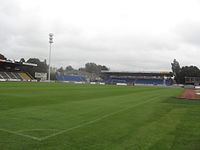
Boulogne's football club, US Boulogne Côte d'Opale (US refers to Union Sportive), is one of the oldest in France due to the city's proximity to England, founded in 1898. The club currently play in the third tier, the Championnat National, and host home matches at the 14,500-capacity Stade de la Libération.[12] Boulogne native and FIFA World Cup finalist Franck Ribéry began his career at the club.[13]
Basketball teams in Boulogne include Stade Olympique Maritime Boulonnais of the Nationale 1 and ESSM of Pro B.
Culture
- The Château de Boulogne-sur-Mer (now a castle museum) of Boulogne, in the fortified town, houses the most important exhibition of masks from Alaska in the world, the second largest collection of Greek ceramics in France (after the Louvre), collections of Roman and medieval sculptures, paintings (15th-20th century), an Egyptian collection, African Arts etc. As these collections are exhibited in a medieval castle, one can also discover the Roman walls (in the underground) as well as rooms built in the 13th century (La Barbière, banqueting hall, chapel, covered parapet walk...)
- La Casa San Martin is currently a museum where José de San Martín the leader of independence struggle in Argentina died in 1850, from 1930 to 1967 this house was the consulate of Argentina in France. There is a statue dedicated to his colleague Simón Bolívar, the liberator of South America in the revolutions against Spanish colonial rule in the 1810s. Bolivar planned to head in exile to this very part of France before his death in 1830. Historic emigration in the 19th century from the Nord-Pas de Calais region to Argentina, Chile, Peru and Venezuela can explain some cultural ties with South America of the Boulognais and Latino/Ibero-American culture. [citation needed]
- Nausicaä, the French national sealife centre.
Food
As an international maritime port on the English Channel (La Manche), the town of Boulogne-sur-Mer has European and American influences in local cuisine. They include:
- Welsh rarebit (from Wales, United Kingdom)
- Sandwich américain (an American sandwich introduced from the USA)
- Kipper (Flemish: smoked herring)
Notable people
Born in Boulogne

- Matilda of Boulogne (1105–1152), Countess of Boulogne and queen consort of England
- Frédéric Sauvage (1786–1857), engineer and inventor of the propeller
- Pierre Claude François Daunou (1761–1840), politician and historian
- Charles Augustin Sainte-Beuve (1804–1869), literary critic and one of the major figures of French literary history
- Guillaume Duchenne (1806–1875), neurologist
- Henri Malo, writer and historian
- Alexandre Guilmant (1837–1911), organist/composer
- Ernest Hamy (1842–1908), anthropologist/ethnologist; created (in 1880) the museum of ethnography of Trocadéro (today known as the Musée de l'Homme, Trocadéro)
- Le Quien (1661–1733), Michel. monk and historian.
- Auguste Mariette (1821–1881), scholar and archaeologist, one of the foremost Egyptologists of his generation, and the founder of the Egyptian Museum in Cairo
- Benoît-Constant Coquelin (1841–1909), actor
- Ernest Alexandre Honoré Coquelin (1848–1909), actor
- Léo Marjane (born 1912), singer
- Georges Mathieu (born 1921), famous painter, initiator of "lyrical abstraction" and informal art
- Sophie Daumier (1934–2004), film actress
- Estha Essombe (born 1963), judoka
- Jean-Pierre Papin (born 1963), footballer
- Mickaël Bourgain (born 1980), track cyclist
- Franck Ribéry (born 1983), footballer
- Terence Makengo (born 1992), footballer
- SebastiAn (born 1981), French electronic musician
Others associated with Boulogne

- Godfrey of Bouillon, count of Boulogne, prominent figure in the First Crusade
- Baldwin I of Jerusalem, count of Boulogne, prominent figure in the First Crusade
- Blaise de Monluc, marshal of France
- José de San Martín, Argentine general who liberated Argentina and Peru; lived for two years in Boulogne and died here in 1850
- Maurice Boitel (born 1919), painter
- Constant Coquelin, actor
- Jacques-Oudart Fourmentin aka "Le Baron Bucaille", corsair
- Benoît-Agathon Haffreingue, priest and builder of Boulogne's cathedral
- Olivier Latry (b. 1962), musician, educator
- John McCrae (1872–1918), Canadian doctor, poet; author of "In Flanders Field"
- Alfred-Georges Regner (1902–1987), painter-engraver
- Smithson Tennant (1761–1815), chemist, discoverer of osmium and iridium, died falling from a bridge in Boulogne
International relations
Twin towns — Sister cities
Boulogne-sur-Mer is twinned with:
 Folkestone, United Kingdom
Folkestone, United Kingdom La Plata, Argentina
La Plata, Argentina Zweibrücken, Germany - since 1959
Zweibrücken, Germany - since 1959
See also
References
- ^ "C'est l'Actu juillet 2010". Ville-boulogne-sur-mer.fr. Retrieved 2013-03-26.
- ^ France. "Ville de Boulogne-sur-Mer - La Commune, la Mairie de Boulogne-sur-Mer et sa ville - Pas-de-Calais en France". Annuaire-mairie.fr. Retrieved 2013-03-26.
- ^ Graeme Villeret. "France". PopulationData.net. Retrieved 2013-03-26.
- ^ "Boulogne-sur-Mer Tourist Guide". Information France. 2010-06-01. Retrieved 2013-03-26.
- ^ a b "Les Beffrois au patrimoine de l'Humanité". Nordmag.fr. Retrieved 2013-03-26.
- ^ a b c d "Boulogne-sur-Mer (Municipality, Pas-de-Calais, France)". Flagspot.net. Retrieved 2013-03-26.
- ^ Historia Nova, Book VI.5.2-3
- ^ David Baker, The rocket: the history and development of rocket & missile technology. Taylor & Francis, 1978, p.13.
- ^ "2nd Battalion Irish Guards. - World War 2 Talk". Ww2talk.com. Retrieved 2012-07-03.
- ^ Stacey, C P (1966). "Clearing the Coastal Belt and the Ports September 1944 - Operation "WELLHIT"; The Capture of Boulogne". Official History of the Canadian Army. Department of National Defence. Retrieved 24 June 2009.
{{cite web}}: Cite has empty unknown parameter:|coauthors=(help) - ^ http://uk.megabus.com/routemap.aspx
- ^ "Football Boulogne : Union Sportive Boulogne Côte d Opale (USBCO)". Foot-national.com. Retrieved 2013-03-26.
- ^ http://www.goal.com/en-gb/people/france/6241/franck-ribéry/profile
Further reading
- "Boulogne", A Handbook for Travellers in France (8th ed.), London: John Murray, 1861
{{citation}}: External link in|chapterurl=|chapterurl=ignored (|chapter-url=suggested) (help)
- "Boulogne-sur-Mer", Northern France (3rd ed.), Leipsic: Karl Baedeker, 1899, OCLC 2229516
{{citation}}: External link in|chapterurl=|chapterurl=ignored (|chapter-url=suggested) (help)
- "Boulogne-sur-Mer", The Encyclopaedia Britannica (11th ed.), New York: Encyclopaedia Britannica, 1910, OCLC 14782424
{{citation}}: External link in|chapterurl=|chapterurl=ignored (|chapter-url=suggested) (help)
External links
- INSEE Template:En icon
- IGN Template:En icon
- Official website: Tourism in Boulogne sur Mer and the Boulonnais area (in English)
- Boulogne-sur-Mer city council website (in French)
- Visiting Boulogne-sur-Mer (English guide and tourist map)
- NAUSICAÄ's official website (in French and English)
- Boulogne 2005 Esperanto
- Universite d'ete de Boulogne-sur-Mer
- The university library of ULCO
- The Boulogne Eastern Cemetery on the website "Remembrance Trails of the Great War in Northern France"


